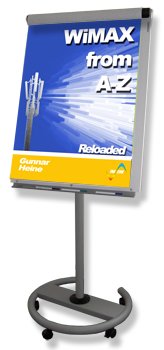 WiMAX from A-Z - Reloaded
WiMAX from A-Z - Reloaded
[2-day course, Euro 2,350.- (net) per participant]
 Training Course Description
Training Course Description

- This training course addresses the needs of engineers and technicians who need to understand WiMAX technology and system operation in detail. This includes the special requirements of design and test engineers of WiMAX-equipment on both ends, network and CPE.
- In that respect, the focus is on the latest revision of the standard which is IEEE 802.16e-2005 and also considers the upcoming changes of corrigendum 2 and task group 802.16m.
- The training course starts with an overview of the IEEE 802.16 family of standards and WiMAX. This part includes the definition of stationary, nomadic and mobile access scenarios and points out the differences among them. In the same chapter we illustrate the basic e2e-architectural aspects of ASN and CSN and we present the frequency ranges of WiMAX.
- The following part is dedicated to the detailed description and discussion of the e2e-architecture of WiMAX-networks. Different implementation options are presented like Greenfield architecture or integration of WiMAX-networks into existing DSL- or 3G-architectures.
- This part includes the consideration of the different ASN-implementation options along the profiles A, B and C.
- The training course continues with a detailed description of the OFDMA physical layer of WiMAX. After a comprehensive introduction to OFDM, the focus is on aspects like OFDMA-tiles and zones (PUSC, FUSC, …) and their differences and on the mapping of user data to ODFMA-subchannels and slots.
- The following chapter deals with other aspects of the physical layer, namely a detailed description of MIMO and AAS in WiMAX and the presentation of the signal processing chain (randomization, FEC, modulation). This part includes an introduction to HARQ-techniques like chase combining and incremental redundancy.
- Yet, the major of this chapter is the presentation of the OFDMA-specific layer 1 frame and the means and mechanics of uplink and downlink resource allocation or ranging within this frame structure.
- In the following chapter, the training course focuses on the WiMAX-protocol suite, covering protocols like MAC, ASN-Ctrl, PKMv2 and Mobile-IP (CMIP and PMIP). This chapter contains the description of important scenarios like idle mode activation and deactivation, paging, and ASN-based mobility management.
- The final chapter is dedicated to different e2e-scenarios like initial registration of a CPE to the network under different conditions and using different credentials. This section illustrates the optimum interworking of WiMAX-networks with the IMS and it covers CSN-based mobility management aspects.
Please click here for a detailed Table of Contents (ToC)
Some of your questions that will be answered
- How does the e2e-network architecture of WiMAX look like under different conditions (Greenfield, DSL-operator, mobile operator)?
- Which mobility management options exist in WiMAX-networks and how do they differ?
- How do OFDM and OFDMA work? How can there be soft handover in OFDMA?
- What are the differences between PUSC, FUSC or AMC in OFDMA?
- What do we have to consider when setting up single frequency network operation with our WiMAX OFDMA-network?
- What is Fractional Frequency Reuse?
- How does WiMAX provide for QoS? Which parameters are used?
- In which frequency bands will WiMAX actually be deployed?
- How does MIMO work in WiMAX and how does it impact the operation? How do MIMO Matrix A, B and C differ?
- How do procedures like sleep mode, idle mode, paging and handover operate in detail?
- How can the PKMv2-security architecture of WiMAX be integrated into our existing security architecture?
 Who should attend this class?
Who should attend this class?
- Engineers and technical staff who require detailed inside knowledge of the WiMAX- and IEEE 802.16e-standards.
 Pre-Requisites
Pre-Requisites
- The student should possess detailed knowledge of wireless communications, particularly within the area of digital signal processing in wireless communications.
- This experience should stem from hands-on work in the area of design, integration, test or troubleshooting of GSM, CDMA or WCDMA-equipment.
- Comprehension of different digital modulation schemes like QAM or PSK and of different multiple access schemes like TDMA, FDMA and CDMA is required.
- Knowledge of the TCP/IP-protocol environment and particularly of the IP security issues e.g. in WLAN’s is necessary.
 Training Course Target
Training Course Target
- The student will obtain detailed understanding of WiMAX and the IEEE 802.16e standard and the related procedures and network operation and architectures.
- After the training course the student will be enabled to design, test and operate 802.16 networks and CPE’s.
 Training Course Duration
Training Course Duration
- 2 days
v2.111
ℹ️ Try out the updated search below!
Search:
More Info:
Detailed ToC of this training course
Schedule of this training course
Extract of this training course
Buy this book
Buy this book as eBook
INACON eBooks
Please have a look at our full offer

